|
|
|
|
QUITO:
SIGHTS in a NUTSHELL
Mish-mash of Dominic
Hamilton and Derek Davies text
Photos by
Dominic Hamilton
|
|
 |
 |
|
The
Old Town
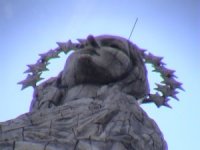 Best views: Best views:The neo-gothic Basílica
del Voto Nacional, the highest church in the country.
Take the lift in the left tower up to the lookout terrace,
where there's also a handy, if quirky, café, open
9:30 am to 5 pm every day.
The Panecillo
('little loaf of bread') hill, with the huge, winged
statue, of the Virgen de Quito trampling on a dragon,
the city's most prominent landmark. Take a taxi. Also check
out the restored Monasterio de San Diego on Calicuchima
117 and Farfán, to the east of the Panecillo hill.
Best churches:
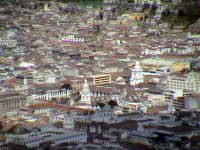 The Cathedral,
though grand and imposing from the outside, is a disappointment
inside, despite guarding the tomb of Grand Marshal Sucre,
and being the site of the poisoning of the city's bishop
in 1877. The Cathedral,
though grand and imposing from the outside, is a disappointment
inside, despite guarding the tomb of Grand Marshal Sucre,
and being the site of the poisoning of the city's bishop
in 1877.
The main chapel
of the cathedral, the beautiful El Sagrario, recently
restored.
Magnificent
volcanic stone façade of La Compañía
de Jesús, considered to be the loveliest church
in Ecuador. Built by the Jesuits, its massive altars, baroque
columns and ceilings are laden with tonnes of gold leaf,
though some of its most precious treasures are kept in the
vault of Banco Central and only displayed on festival days.
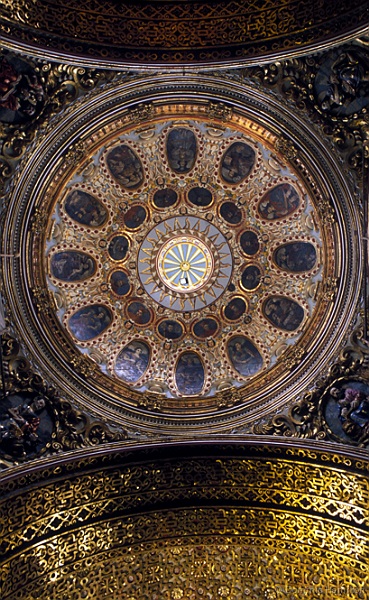 The huge Iglesia
de San Francisco, South America's oldest church, begun
soon after the city was founded, in 1536. The church's interior
rivals that of La Compañía, with more gold
leaf than a conquistador could have dreamed of. Highlights
include the unique carving of the winged Virgin by Bernardo
de Legarda, and the altar and paintings of La Capilla
de Cantuña, an adjoining chapel. The huge Iglesia
de San Francisco, South America's oldest church, begun
soon after the city was founded, in 1536. The church's interior
rivals that of La Compañía, with more gold
leaf than a conquistador could have dreamed of. Highlights
include the unique carving of the winged Virgin by Bernardo
de Legarda, and the altar and paintings of La Capilla
de Cantuña, an adjoining chapel.
Iglesia Santo
Domingo, one of Quito's earliest. The interior and altar
were redesigned in the nineteenth century, and pretty much
ruined it, though the Chapel of the Rosary to the right
of the altar is still a delight.
Iglesia La
Merced, built to commemorate the eruptions of Volcán
Pichincha that threatened to destroy the city. Paintings,
amid the pink, white and gold leaf extravaganza inside,
show scenes of erupting volcanoes. The cloisters of the
adjoining convent are especially beautiful.
The small Church of San Blas, one of the few churches open
to Indians in colonial times.
Ornate carvings
on the doors of the El Carmen Bajo church.
San Agustín begun in the sixteenth century. Much of the church was
rebuilt in the nineteenth century, but its dark interior
and large canvases are still captivating. The adjoining
convent boasts a lovely cloister, housing a museum of important
paintings of the Quito School.
Best Museums:
Museo de
San Francisco, open Monday to Saturday 9 am to 6 pm,
Sunday 9 am to noon. Beautiful cloisters and the excellent
collection of paintings, furniture and sculpture which once
housed the city's School of Painting and Arts - you'll note
the remnants of the pupil's paintings on the walls. The
tour also includes a visit to the church's choir with its
fantastic mudejar (Moorish) ceiling, whose symmetrical
patterns and gold leaf seem to float off up to heaven.
Museo
de la Ciudad, open 9:30 am to 5:30 pm Tuesday to
Sunday. Imparts a dynamic and occasionally interactive view
of the city's social history, from its prehistoric inhabitants
to the present day. The museum is housed within the beautiful
Hospital San Juan de Dios, where the poor and sick were
cared for until it closed 1974. Watch out for the extraordinary
series of three large canvases depicting the Conquest by
contemporary artist Jaime Zapata.
Museo Fray
Pedro Bedón showcases many beautiful Dominican
treasures from the sixteenth to eighteenth centuries. It's
open daily from 8 am to 5 pm.
Casa de María
Augusta Urrutia, a nineteenth century house with its
three patios offers a wonderful peek at the high society
world of Quito, with its European furniture, sewing rooms,
drawing rooms and salons.
Casa de Sucre,
the house of the dashing liberator Grand Marshal Antonio
José de Sucre, (Calle Sucre at the corner of Venezuela;
open Tuesday to Saturday 8:30 am to 4:30 pm) is another
fine late-colonial house. Though much of the exhibits pertain
to military history, there are also many impressive examples
of period furniture and painting.
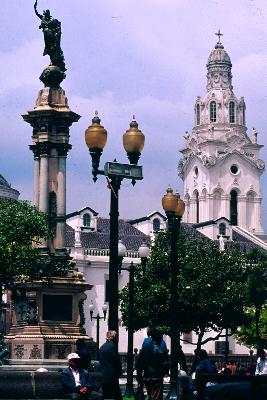 Squares: Squares:
Plaza
de la Independencia (known locally as Plaza Grande). The
square is overlooked by a number of distinguished civic buildings
and is the setting for the Victorian-style Liberty Monument
in the midst of palms and flowerbeds, old men and children,
shoe-shiners and benches. The Presidential Palace, the Archbishop's
Palace, the modern City Administration Building and the Cathedral
command the locus of the old town.
Plaza de San Francisco
Plaza del Teatro
Also:
La Ronda,
with some charming Spanish-style houses with balconies,
reminiscent of Barrio Santa Cruz in Seville, with tile portraits
of famous musicians and composers adorning some of the houses'
walls.
Tanguiez:
A good place to recharge your batteries or grab a light
lunch. A café and artesanía shop at the foot
of the Iglesia de San Francisco's steps.
The New Town:
Parque La
Alameda and the Quito Observatory
Palacio Legislativo
Parque El Ejido, Quito's biggest downtown park.
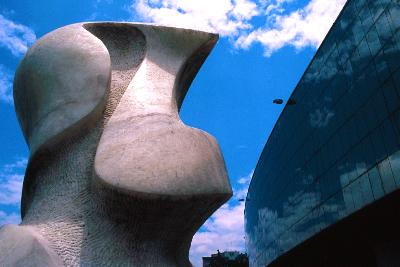
Casa de la Cultura Complex
Museo Nacional
del Banco Central del Ecuador offers a wide cultural
and artistic perspective on Ecuador's proud history - and
some exhibits, such as an extraordinary ceremonial gold
mask, will make your chin drop. The Sala de Arqueología;
Sala de Oro; colonial, Republican and contemporary
art.
Casa de la
Cultura museum complex: museums of musical instruments,
Ecuadorian art (particularly Eduardo Kingman's indigenismo
canvases) and traditional dress from indigenous cultures.
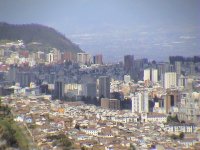 Museo del
Instituto Geográfico Militar, includes a geographical
museum and a planetarium with shows several times a day. Museo del
Instituto Geográfico Militar, includes a geographical
museum and a planetarium with shows several times a day.
Museo Guayasamín,
a cultural multiplex covering pre-Columbian, colonial and
contemporary art but on a smaller, more personal scale than
the Banco Central or Casa de la Cultura. The best of the
museum is the powerful, harrowing paintings of the internationally-known
artist, Oswaldo Guayasamín, while the pre-Columbian
and colonial sections belonged to his private collection.
Vivarium,
a living showcase of many of the species found in Ecuador:
deadly fer-de-lances and anacondas, as well as iguanas,
turtles and tortoises (a vivarium is an artificial enclosure
for keeping or raising living animals).
See New Sights for info on the Jardin Botanico
Museo de
Ciencias Naturales.
The Museo
Amazónico, small but interesting collection of
artifacts, weapons, costumes, photographs, videos and books
on Indian cultures. The collection is housed within the
Abya-Yala building, which includes an unsurpassed bookshop
on indigenous issues (mainly in Spanish). Av. 12 de Octubre
1430 y Wilson.
Tel (022) 562633, 506247- FAX (022) 506255
www.abyayala.org
The museum of
the Fundación Sincha Sacha has ethnographic
artifacts, information on the peoples of the rainforest
and a gift shop.
Seventeenth-century
Santuario de Guápulo with its with beautiful
paintings and sculpture, and a lovely carved pulpit. The
district is also a steep and cobbled haven from downtown
Quito, yet very close.
|
 |
|
 |
GOOD NEWS!
ECUADORIAL HAS TEAMED UP WITH GUIDE2GALAPAGOS.COM TO OFFER YOU THE BEST VALUE GALAPAGOS CRUISES.
GUIDE2GALAPAGOS is an offshoot of the highly-professional and experienced Sangay Touring. They will find the best prices on the best boats — and aren't afraid not to recommend a vessel if it doesn't live up to their standards. |
| |
To celebrate the deal, Guide2Galapagos is offering Ecuadorial visitors an exclusive offer:
Book a Luxury class yacht with them, and they'll give you THREE AIRPORT TRANSFERS FOR FREE; two for first class and one for tourist-superior.
So, what are you waiting for? Check out their highly-informative site. Blue boobies, giant tortoises, sealions and marine iguanas are only a click or two away!
SMALL PRINT: On the request page, you must state you came from Ecuadorial to benefit from the airport transfer offer. |
|
|
 Go to top Go to top 
All material on this site is © Ecuadorial.com/The Authors
(unless otherwise stated).
Site designed and maintained by Dominic
Hamilton.
|